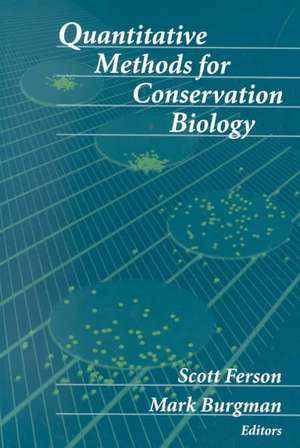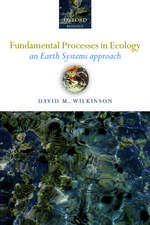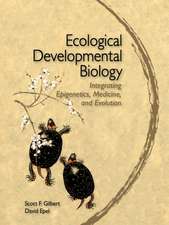Quantitative Methods for Conservation Biology
Editat de Scott Ferson, Mark Burgmanen Limba Engleză Paperback – 13 iun 2002
Preț: 642.68 lei
Preț vechi: 756.09 lei
-15% Nou
Puncte Express: 964
Preț estimativ în valută:
122.98€ • 134.00$ • 103.63£
122.98€ • 134.00$ • 103.63£
Carte tipărită la comandă
Livrare economică 23 aprilie-07 mai
Preluare comenzi: 021 569.72.76
Specificații
ISBN-13: 9780387954868
ISBN-10: 0387954864
Pagini: 322
Ilustrații: XI, 322 p. 5 illus.
Dimensiuni: 155 x 235 x 16 mm
Greutate: 0.48 kg
Ediția:Softcover reprint of the original 1st ed. 2002
Editura: Springer
Colecția Springer
Locul publicării:New York, NY, United States
ISBN-10: 0387954864
Pagini: 322
Ilustrații: XI, 322 p. 5 illus.
Dimensiuni: 155 x 235 x 16 mm
Greutate: 0.48 kg
Ediția:Softcover reprint of the original 1st ed. 2002
Editura: Springer
Colecția Springer
Locul publicării:New York, NY, United States
Public țintă
ResearchCuprins
Detecting Extinction in Sighting Data.- Inferring Threat from Scientific Collections: Power Tests and an Application to Western Australian Acacia Species.- Identifying the Ecological Correlates of Extinction-Prone Species: A Case Study of New Zealand Birds.- Quantitative Methods for Modeling Species Habitat: Comparative Performance and an Application to Australian Plants.- Risk Assessment of a Proposed Introduction of Pacific Salmon in the Delaware River Basin.- Likelihood of Introducing Nonindigenous Organisms with Agricultural Commodities: Probabilistic Estimation.- “Best” Abundance Estimates and Best Management: Why They Are Not the Same.- Whaling Models for Cetacean Conservation.- Assessing Land-Use Impacts on Bull Trout Using Bayesian Belief Networks.- Using Matrix Models to Focus Research and Management Efforts in Conservation.- Variability and Measurement Error in Extinction Risk Analysis: The Northern Spotted Owl on the Olympic Peninsula.- Can Individual-Based Models Yield a Better Assessment of Population Variability?.- Potential of Branching Processes as a Modeling Tool for Conservation Biology.- Role of Genetics in Conservation Biology.- Modeling Problems in Conservation Genetics Using Laboratory Animals Richard Frankham.- Theoretical Properties of Extinction by Inbreeding Depression Under Stochastic Environments.- Mathematical Methods for Identifying Representative Reserve Networks.
Recenzii
From the reviews:
"Population decline and extinction of many species is a worldwide phenomenon. Because quantitative methods are either lacking or not applied population declines are often poorly understood … . The present book aims to contribute to close this gap by introducing several different quantitative methods that are useful to conservationists. … The book has been written for graduate students and working conservation biologists. … The authors succeeded … in presenting the different methods in an understandable and simple way. … I would recommend the book." (Michael Schaub, Basic and Applied Ecology, Issue 5, 2004)
"Population decline and extinction of many species is a worldwide phenomenon. Because quantitative methods are either lacking or not applied population declines are often poorly understood … . The present book aims to contribute to close this gap by introducing several different quantitative methods that are useful to conservationists. … The book has been written for graduate students and working conservation biologists. … The authors succeeded … in presenting the different methods in an understandable and simple way. … I would recommend the book." (Michael Schaub, Basic and Applied Ecology, Issue 5, 2004)
















